New Chromatography Columns and Accessories at Pittcon 2009: Part II
LCGC North America
Ron Majors brings readers the second part of his yearly review of all that was new and innovative at the annual Pittsburgh Conference.
Pittcon 2009, the 60th Pittsburgh Conference on Analytical Chemistry and Applied Spectroscopy, was held in the massive McCormick Place in Chicago, Illinois, on March 8–13, 2009, the sixth time the Conference has been held there. This year's event hosted nearly 1000 instrument manufacturers and laboratory suppliers in more than 2200 booths. In addition to attending the exposition, the conferees listened to 2500 technical presentations, checked numerous company seminar rooms, or attended one or more of 100 short courses.

Ronald E. Majors
Undoubtedly, Pittcon remains the most important yearly international analytical exhibition, where companies introduce their latest instruments, instrument accessories, software, columns, sample preparation equipment, and other consumable products. Because many past attendees have purchased one or more new products within three months after attending the show, most exhibitors attempt to maximize their booth traffic to meet as many potential customers as possible.
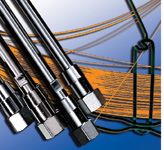
The purpose of this report is to provide information about many of the new separation consumables and accessory products that were displayed at Pittcon 2009. In some cases, products that were introduced during 2008 but after Pittcon 2008 (1,2) might be included for reasons of completeness. The information is based upon manufacturers' responses to a questionnaire mailed in December 2008. Because of space limitations and the fact that some manufacturers did not respond to the questionnaire, this report cannot be considered an exhaustive listing of all new products that were introduced in Chicago. However, over the years, these Pittcon introduction summaries have provided a good source of information that would be difficult for one individual to gather during the four days of the exhibition. In addition, the products introduced have shown definite correlations to current research, development, and application activity in the separation sciences.
As in previous years, columns and other products recommended by their manufacturers primarily for biomolecule separations or sample preparation are denoted in the tables with the designation BIO. Some of these products can be used for general high performance liquid chromatography (HPLC) separations as well, but their main emphasis is for biological samples.
In this month's coverage, I will look at gas chromatography (GC) columns, sample preparation products, and hardware, accessories and kits for chromatography, and sample preparation. Last month, I described new introductions in the areas of HPLC; reversed-phase, normal- and bonded-phase, ion-exchange and ion, size-exclusion, and large- and preparative-scale chromatography; specialty chromatography columns; and thin-layer chromatography (TLC).

Table I: Gas chromatography columns
Gas Chromatography (GC)
Although GC is considered to be a relatively mature separation technique, new GC columns continue to be introduced each year at Pittcon (Table I), 11 in all for this year. A major portion of the GC columns were the wall-coated open tubular (WCOT) format but this year three new porous layer open tubular (PLOT) columns were shown. PLOT columns contain a thin layer of solid support on the internal surface of a fused-silica or metal capillary. Recent advances have come up with new technologies to ensure that the tiny stationary phase particles do not flake off of the column causing downstream problems such as detection spikes and flow fluctuations. The three PLOT columns introduced by Restek (Bellefonte, Pennsylvania) have molecular sieve, alumina, and porous polymer particles affixed to the capillary surface. PLOT columns are used generally for the separation of small volatile molecules such as solvents, hydrocarbons, and a wide range of gases including permanent gases.
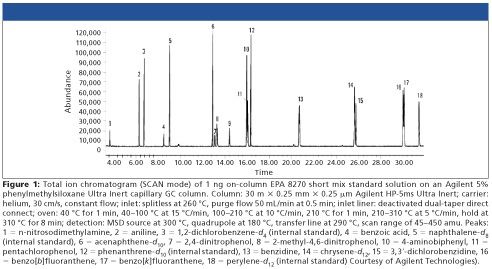
Figure 1
In recent years, there has been a trend in the introduction of low bleed and very inert columns that can be used for the analysis of increasingly smaller concentrations of polar compounds. For example, trace level semivolatile organics analysis using methods such as the EPA Method 8270 are important tools for accessing environmental contaminants worldwide. Thus, new levels of inertness are needed to tackle increasingly lower concentrations. This year two companies introduced new lines of inert WCOT columns. Agilent Technologies (Wilmington, Delaware) extended its family of DB- and HP-Ultra Inert line of GC capillary columns with the introduction of 1- and 5-MS columns that are tested individually with probes selected to provide in-depth evaluation of inertness. Also, Abel Industries (Newark, Delaware) introduced its AB-5-MS column that showed good inertness (low tailing/high recovery) with polar test probes — 4-chlorophenol, decylamine, and 1-dodecanol. Figure 1 and 2 show results of these challenging test probes on both of these columns.

Figure 2
Application-specific columns are always popular introductions at the exposition. With the recent increased prices of petroleum-based fuels, alternative bio-based fuels have received increased attention. Column sets for biodiesel analysis were introduced by two companies and a bioethanol column by another (Table I). Both the European (DIN EN) and American (ASTM D) standards committees have established testing criteria for these new types of fuels. Diesel engines are designed to run optimally with fuels with certain specifications. Such specifications for FAMES, residual methanol, residual glycerin, and other biodiesel components are important in ensuring that the fuels meet the required standards. Similar standards are published for bioethanol obtained by biofermentation reactions. Other application-specific GC capillary columns introduced at Pittcon included those for blood alcohol analysis, drugs of abuse, and brominated flame retardants.

Table II: Sample preparation products
Sample Preparation Products
As indicated in Table II, Pittcon '09 was another productive year with 22 new sample preparation products or families of products displayed. Not counted were sample preparation accessories (Table III), which will be covered later. Among the more popular introductions were products to deal with increasingly smaller amounts of available sample. Many solid-phase extraction (SPE) products ranging from cartridges, to pipette tips, to 96-well plates, and solid-phase macroextraction were among the formats introduced. Just about every mode of SPE (reversed phase, strong anion and cation exchange, adsorption–normal phase, complexation, mixed mode, molecular imprinting, and hydrophilic interaction chromatography [HILIC]) was displayed. A wide variety of media were introduced at Pittcon including polymer-based, graphitized carbon black, silica-based and a number of other inorganic oxides (for example, ZrO2, TiO2, Al2O3).

Table II: Continued
Some unique products were to be seen on the Pittcon floor. Products that combine protein precipitation with SPE for the sample cleanup of biological fluids were noted at several booths. The Supelco (Bellefonte, Pennsylvania) HybridSPE product, useful for the analysis of drugs in biological fluids, combines protein precipitation with removal of phospholipids using Zr-coated silica particle as an SPE medium. One of the major causes of ion suppression in bioanalysis is the presence of phospholipids during liquid chromatography–mass spectrometry (LC–MS) or LC–MS-MS analysis in the positive-ion electrospray mode. The removal of most phospholipids is accomplished in a 96-well or cartridge format. Varian (Walnut Creek, California), although not physically present at Pittcon this year, introduced a non-drip filtration plate called the Captiva NDLipids that also combines protein precipitation with phospholipid removal via a lipid-depleting filter. Agela (Newark, Delaware) uses a mixed-phase polymer with a basic functional group that they claim removes much of the matrix while leaving analytes untouched thereby giving a cleaner extract than protein precipitation only. Evolute CX, a product of Biotage (Charlottesville, Virginia), is also a mixed-mode phase that performs a similar function.
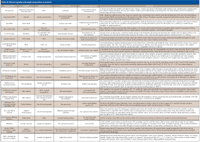
Table III: Chromatography and sample preparation accessories
Polymeric SPE sorbents have become popular in recent years. Polymeric SPE devices are particularly attractive because they can dry out during the conditioning steps without affecting the recovery and reproducibility of the SPE experiment. They also can be treated with more aggressive washing solvents than silica-based sorbents. Oasis HLB, a hydrophilic-lipophilic balanced N-vinylpyrrolidone-DVB SPE copolymer manufactured by Waters (Milford, Massachusetts), has been incorporated into the disk format by Horizon Technology (Salem, New Hampshire) and used for environmental samples such as organics in drinking and waste water. Disks allow much higher flow rates than cartridges due to their larger cross sectional areas. Horizon has a semi-automated instrument that can handle one-liter bottles of water sample and accommodates various types of disks. Supelco introduced Supel-Select HLB modified styrene polymer which operates mainly in the reversed-phase mode but due to its hydrophilic character can retain polar compounds. Agilent introduced an entirely new line of polymer-based SampliQ SPE products. The cartridges and 96-well plates are based upon an HLB polyamide. Cation- and anion-exchange polymers also are available.

Table III: Continued
Products for QuEChERS were first introduced last year (2). Pronounced "catchers," QuEChERS is an acronym for Quick, Easy, Cheap, Effective, Rugged and Safe sample preparation. This method is an emerging technique becoming increasingly popular in the area of multi-residue pesticide analysis in food and agricultural products. In QuEChERS, food and agricultural samples are first extracted with an aqueous miscible solvent (for example, acetonitrile) in the presence of high amounts of salts (for example, sodium chloride and magnesium sulfate) and buffering agents (for example, citrate) to induce liquid phase separation and stabilize acid- and base-labile pesticides, respectively. After shaking and centrifugation, an aliquot of the organic phase is subjected to further clean up using SPE. Unlike traditional methods using SPE tubes, dispersive SPE cleanup is conducted by mixing bulk amounts of SPE sorbent with the extract. After sample cleanup, the mixture is centrifuged and the resulting supernatant can either be analyzed directly or can be subjected to minor further treatment before analysis. Three new QuEChERS products were submitted for inclusion into my Pittcon 2009 article. (see Table II). For those interested, a brief introduction to the technique was published in an earlier installment of "Sample Preparation Perspectives" (3).
Beside QuEChERS, which is used in food safety analysis, other application-specific SPE phases were introduced this year. In the environmental area, the SPE technique is now well accepted by regulatory agencies as a substitute for older methodologies like liquid–liquid extraction. A number of phases specifically for environmental samples were introduced covering EPA Methods 521, 8270, and 8290. Of all SPE-type of sorbents, applications of molecularly imprinted polymers (MIPs) are the most very compound or class specific. This year MIPs, introduced by Supelco/Sigma Aldrich as the SupelMIPs, were extended to cover the isolation of amphetamines from urine and fluoroquinolones from meat products (see Table II). To illustrate the use of the MIP technologies for the investigation of amphetamines and related drugs in urine, Figure 3 shows the MRM chromatograms in spiked urine (left of Figure 3). The right chromatograms show as follows: upper, Q1 scans at 150 amu for a standard showing methamphetamime and phentermine peaks; middle, extract after SupelMIP extraction; and lower, extract after polymer SPE cleanup. The Q1 scans at 150 amu reveal interferences which are ionized and pass into the MS detector in addition to methamphetamine and phentermine. Figure 3 shows that in the 6–10 min retention window, where all the amphetamines are eluted, the MIP chromatogram is much cleaner than the polymer SPE extract.

Figure 3
In recent years, SPE pipette tips with specific phases are finding use in small samples for drugs of abuse, biological compounds, oligosaccharides, and phosphopeptides. A number of them were introduced this year at Pittcon. As an alternative to 96-well plates, this format is quite amenable to automation as many liquid handling systems are adapted to moving liquids through the tips; the flow through the tips can be bidirectional, which means that they can be loaded from the top or liquids can be drawn up from their base. Phases are often embedded onto the walls through chemical "gluing" processes. A slightly different approach to conventional SPE is the DPX (Dispersive Pipette Extraction) system from DPX Labs (Columbia, South Carolina). The DPX pipette tips have loose sorbent rather than fixed (embedded) sorbent and the sorbent is contained within the tip by a barrier on the top and a stainless steel screen at the pointed end. As depicted in Figure 4, liquid can be dispensed or drawn into the "void" volume of the pipette tip and allowed to come in intimate contact with the loose packing. In this approach, all of the SPE steps are performed by dispensing–drawing the various liquids into the pipette tip. The DPX technology has been automated by Gerstel (Linthicum, Maryland).
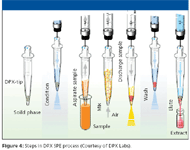
Figure 4
Filtration is one of the most important sample preparation techniques for HPLC, particularly as the column dimensions and particle sizes decrease. Syringe filters are by far the most widely used sample cleanup product and filtration is often the last step before injection into the liquid chromatograph. Removal of particulates can prolong column life and prevent inlet frits from clogging creating pressure problems. This year a number of new filtration devices were introduced. An interesting and simple filtration device, designed mainly for inorganic digests but likely applicable to organic samples as well, is the Digifilter (SCP Science, Champlain, New York). Figure 5 depicts how the filter works. Basically, a liquid sample is added to a tube (Digitube) that is then connected to a membrane filter holder with a plug at one end. A syringe is affixed to the holder; the plug removed and as the plunger is withdrawn liquid is directed to a collection tube below. Filters are constructed of PTFE with 0.45- or 1.0-μm porosity.

Figure 5
Chromatography and Sample Preparation Accessories
Table V lists 32 new hardware products and accessories for HPLC, GC, capillary electrophoresis (CE), and sample preparation. This year I have extended the columns and sample preparation accessories to include dedicated instruments that are designated to automate some of the sample preparation techniques reported in Table II. All of the products introduced were practical devices designed to make the chromatographer's life easier. I will cover each area individually.
HPLC, LC–MS, and ion chromatography products: With the current worldwide shortage of acetonitrile, chromatographers are looking for ways to use less solvent. So the introduction of two solvent recycling systems for isocratic mobile phases could be welcome. These devices work in conjunction with a detector signal. When a peak is detected, a signal goes to a diverter valve that directs solvent to waste and when there is a baseline only signal the solvent (which should be free of any peaks or impurities) is recycled back into the reservoir. Pump modules for sample introduction, infusion, and other liquid pumping applications were introduced. A new system controller and method development software, along with a column selection system, make method development and solvent screening easier. With the current interest in ultrahigh-pressure liquid chromatography (UHPLC), peripherals capable of handling high pressures have began to pop up. This year, Optimize Technologies (Oregon City, Oregon) has extended its Opti-Guard EXP guard column system with a UHPLC model. The device, pictured in Figure 6, consists of a holder and cartridge column and is rated to 20,000 psi with hand-tight replaceable cartridges. It will interface to any UHPLC column with an auto-adjusting EXP Titanium Hybrid ferrule and special Opti-Lok EXP fitting to provide a zero-dead-volume connection. The total sweep volume (excluding the packed bed) is only 1.4 μL. Cartridges are available with internal diameters of 1.0 and 2.1 mm and lengths of 5 mm.
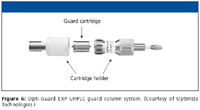
Figure 6
GC products: With the world's supply of helium dwindling and becoming more expensive, users are looking for other carrier gas sources that can provide an inexpensive, safe, pure and plentiful gas supply. Hydrogen gas has superior properties to helium in terms of diffusivity and viscosity but users are often concerned about having additional cylinders of hydrogen around the laboratory. Hydrogen generators can provide carrier gas without fear of safety because only a few tens of milliliters are actually present at any given time. A new hydrogen generator was introduced this year. Just in case, your system does develop a leak, a new leak detector will spot it quickly. If your gas cylinder gets a little low on gas pressure, a new low gas alarm system alerts you by an audible signal or can wirelessly send a message to your PC alerting you to take action.
Sample preparation products: New autosamplers with sample preparation capabilities should help to improve throughput and take away some of the manual sample preparation drudgery. Three companies have introduced such instruments for GC or HPLC. Bar-coded vials should help tracking valuable samples in these automated instruments. A new vial cap crimper will undoubtedly lessen carpal tunnel syndrome for those who have to prepare hundreds of vials a day.

Companies Listed in This Column
Pyrolysis is a useful technique for studying polymer degradation to understand breakdown in high pressure and high temperature conditions. CDS Analytical (Oxford, Pennsylvania), a long-time leader in this area, has introduced a new high pressure system that appears to be very versatile
To go along with the filtration devices introduced in Table II, some semi-automated filtration devices are shown in Table III. A new SPE manifold system was introduced with seize-free connections.
Devices such as evaporators, concentrators, mixers, aspirators, and digestors are designed to take away some of the drudgery of sample preparation. Such products are always found on the Pittcon floor and I list some of those shown this year with improved features over previous models.
I would like to thank the manufacturers and distributors who kindly furnished the requested information in advance of Pittcon 2009, thus allowing a timely report on new product introductions. For those manufacturers who would like to be considered for inclusion into Pittcon 2010 coverage, please send the name of the primary company contact, the mailing address, FAX, and E-mail address to Patrick Kempf, Managing Editor, LCGC North America, c/o Advanstar Communications, 485 Rte. 1 South, Bldg. F, Iselin, NJ 08830, Attn.: Pittcon 2010 "Column Watch."
Ronald E. Majors "Column Watch" Editor Ronald E. Majors is Senior Scientist, Columns and Supplies Division, Agilent Technologies, Wilmington, Delaware, and is a member of LCGC's editorial advisory board. Direct correspondence about this column to "Column Watch," LCGC, Woodbridge Corporate Plaza, 485 Route 1 South, Building F, First Floor, Iselin, NJ 08830, e-mail lcgcedit@lcgcmag.com.

New Study Reviews Chromatography Methods for Flavonoid Analysis
April 21st 2025Flavonoids are widely used metabolites that carry out various functions in different industries, such as food and cosmetics. Detecting, separating, and quantifying them in fruit species can be a complicated process.

.png&w=3840&q=75)

.png&w=3840&q=75)



.png&w=3840&q=75)



.png&w=3840&q=75)











